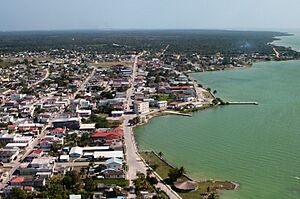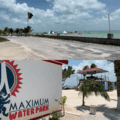Corozal Town facts for kids
Quick facts for kids
Corozal Town
|
|
|---|---|

Aerial of Corozal Town
|
|
| Lua error in Module:Location_map at line 416: Malformed coordinates value. | |
| Country | |
| District | Corozal |
| Constituency | Corozal Bay, Corozal North |
| Elevation | 0 m (0 ft) |
| Population
(2010)
|
|
| • Total | 10,287 |
| • Estimate
(2017)
|
13,502 |
| Demonym(s) | Corozaleño(a) |
| Time zone | UTC-6 (Central) |
| Climate | Aw |
Corozal Town is a lively town in Belize, a country in Central America. It is the main town of the Corozal District. Corozal Town is located about 84 miles north of Belize City. It is also only 9 miles from the border with Mexico.
In 2010, about 9,871 people lived in Corozal Town. Before it became a town in the 1840s, Corozal was a private piece of land. Many of its first settlers were Maya and Mestizo people. They were seeking safety from a conflict called the Caste War of Yucatán. Much of Corozal Town was built on top of an ancient Maya city. This old city is sometimes called Santa Rita. It might have been the original Maya town of Chactemal. This ancient town stretched from today's Corozal all the way to Chetumal, Mexico. In 1955, a strong storm called Hurricane Janet caused a lot of damage to Corozal Town. The town was rebuilt after the hurricane.
Contents
Corozal's History
How Corozal Town Began
Corozal is the northernmost town in Belize. It was started in 1848 by people who had to leave their homes. These people were fleeing from a Maya uprising against the Spanish in Yucatán, a region in Mexico. This uprising was known as the Caste War of Yucatán. It began as a fight against the Spanish. But it later turned into a conflict against the Mestizos. Mestizos are people with both Spanish and Indigenous Maya heritage. They were allies of the Spanish and became enemies of the Maya.
Seeking Safety in Corozal
A terrible event happened in Bacalar, Mexico, which was a Mestizo stronghold. This led to thousands of Mestizos leaving Bacalar and the nearby areas. Between 1848 and 1856, more than 10,000 people crossed the Rio Hondo. This river now forms the border between Belize and Mexico. These new arrivals found a safe place in northern Belize. They helped the population of Corozal Town grow to 4,500 people. A local leader named Mr. James Blake allowed them to settle on land in the Corozal District. He also helped them start growing a new crop: sugar cane.
Defending the Town
The Mestizo people in Corozal Town were not completely safe. Maya groups from Santa Cruz Bravo in Mexico sometimes attacked Corozal Town. To protect the town, Corozal became a "garrison town." This means it had soldiers stationed there. Fort Barlee was built in 1870 for defense. Today, you can still see parts of the fort. Its brick corners surround the post office buildings near the main town square.
Culture and Ancient Sites
The people who moved to Corozal brought their Maya Mestizo culture with them. This included speaking Spanish and Yucatec Maya. They also brought their Catholic faith and Maya stories. They used the "alcalde" system, which is a local leadership role. Their family structures and way of life also came with them. Soon, a society similar to Yucatán's began to grow in Belize.
Across the bay from Corozal Town are the ancient mounds of Cerros. This was the first Maya trading center located on the coast. Cerros is very important because it shows one of the first times Maya leaders became kings. The ruins include temples, plazas, ball courts, and canals. Some interesting items found there are five jade head pendants.
Inside Corozal Town itself, you can find another Maya ruin from the 14th century AD. It's called Santa Rita. This pyramid site sits on top of an ancient Maya city. This city was important in the area for over 2,000 years. Archeologists have found jewelry and other artifacts in burial sites there. Santa Rita is thought to be the center of ancient Chactemal. This was the Maya capital when the Spanish first tried to conquer the Yucatec Mayas in the early 1500s. The Santa Rita ruins are close to the town's hospital. They are also near the villages of San Andres, San Antonio, and Paraiso.
In 1955, Hurricane Janet destroyed about 90% of Corozal Town. Most of the buildings you see today were built after that hurricane. The town has a hospital called Corozal Hospital.
Corozal's Climate
Corozal Town has a tropical climate. This means it is warm all year round. It also has a wet season and a dry season.
| Climate data for Corozal Town (1981–2010) | |||||||||||||
|---|---|---|---|---|---|---|---|---|---|---|---|---|---|
| Month | Jan | Feb | Mar | Apr | May | Jun | Jul | Aug | Sep | Oct | Nov | Dec | Year |
| Mean daily maximum °C (°F) | 28.3 (82.9) |
30.3 (86.5) |
31.6 (88.9) |
32.8 (91.0) |
33.1 (91.6) |
32.8 (91.0) |
32.6 (90.7) |
32.7 (90.9) |
33.0 (91.4) |
31.7 (89.1) |
29.9 (85.8) |
28.7 (83.7) |
31.5 (88.7) |
| Daily mean °C (°F) | 22.8 (73.0) |
24.5 (76.1) |
25.4 (77.7) |
26.7 (80.1) |
28.1 (82.6) |
28.3 (82.9) |
28.0 (82.4) |
27.9 (82.2) |
27.8 (82.0) |
26.6 (79.9) |
24.7 (76.5) |
23.5 (74.3) |
26.2 (79.2) |
| Mean daily minimum °C (°F) | 17.3 (63.1) |
18.7 (65.7) |
19.1 (66.4) |
20.7 (69.3) |
23.0 (73.4) |
23.8 (74.8) |
23.4 (74.1) |
23.2 (73.8) |
22.7 (72.9) |
21.6 (70.9) |
19.5 (67.1) |
18.2 (64.8) |
20.9 (69.6) |
| Average precipitation mm (inches) | 58.5 (2.30) |
31.9 (1.26) |
32.1 (1.26) |
45.7 (1.80) |
107.5 (4.23) |
216.8 (8.54) |
140.4 (5.53) |
172.6 (6.80) |
195.7 (7.70) |
193.7 (7.63) |
95.5 (3.76) |
64.8 (2.55) |
1,355.2 (53.36) |
| Average precipitation days (≥ 1.0 mm) | 7 | 4 | 3 | 3 | 6 | 13 | 11 | 12 | 13 | 12 | 9 | 7 | 100 |
| Source: National Meteorological Service of Belize | |||||||||||||
People of Corozal
Corozal is home to a diverse group of people. In 2010, the population was 10,287. Most people were Mestizo (66.2%). Other groups included Creole (12.7%), Mixed (9.4%), and East Indian (3.1%). There were also smaller groups like Asian, Garifuna, Caucasian, Hindu, and various Maya groups.
Many languages are spoken in Corozal. In 2010, 77.8% of people spoke Spanish. Also, 75.8% spoke English. About 35.1% spoke Creole. Other languages spoken include Mandarin or Cantonese, Hindi, Garifuna, and different Maya languages.
Fun Things to Do
Corozal Town is a place where new and exciting projects are happening.
- Radio Telescope: Corozal Town will soon have a special radio telescope. This telescope is part of the Wernher von Braun Observatory, which is owned by NASA. A radio telescope helps scientists study space by picking up radio waves from stars and galaxies.
- Water Park: In June 2020, the Corozal Town Council received a plan for a new water park. This park was designed to be eco-friendly and world-class. Maximum Water Park opened to the public in April 2021. It offers a fun place for families and friends to enjoy the water.
Image Gallery
See also
 In Spanish: Corozal (Belice) para niños
In Spanish: Corozal (Belice) para niños












